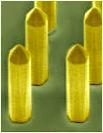This was recently reported as a cover story in Nanotechnology (see paper)
and highlighted in Nanotechweb.org
One of the surprising consequences of the tunnel junction is the finding that light emission also results when the n-type nanowire (GaN) is placed on an n-type substrate (Si). A novel feature of this unipolar device is that by reversing the polarity of the applied voltage the luminescence can be selectively obtained from either the nanowire or the substrate, i.e., a two-color unipolar LED.
This work was recently reported as a featured article in Nanotechnology (see paper) and highlighted in Nanotechweb.org and Optics.org
|


